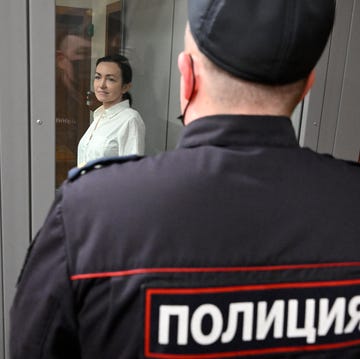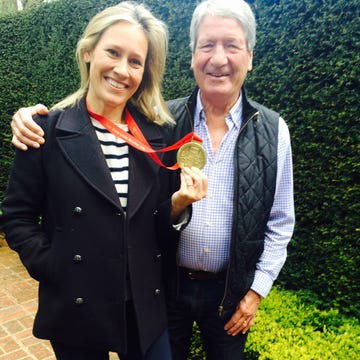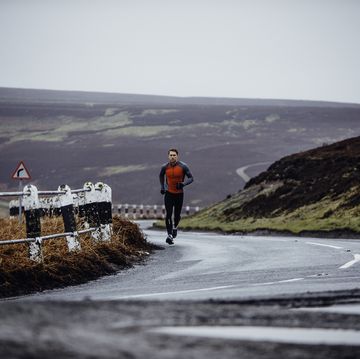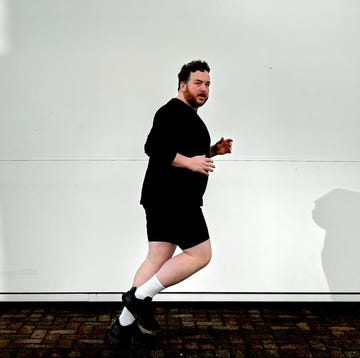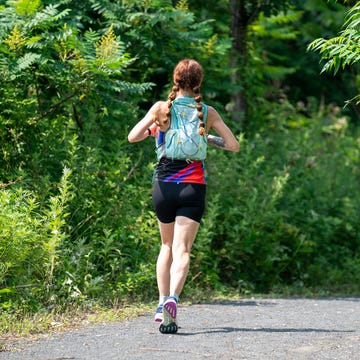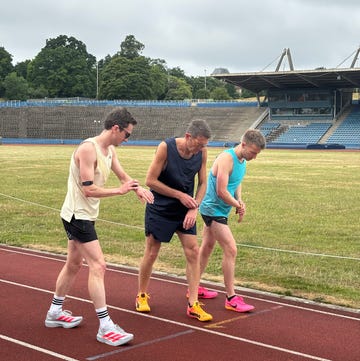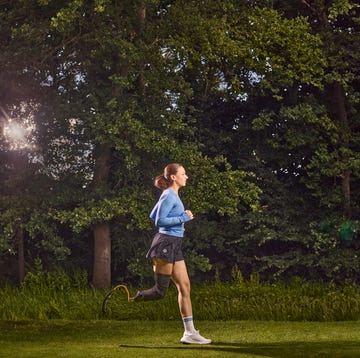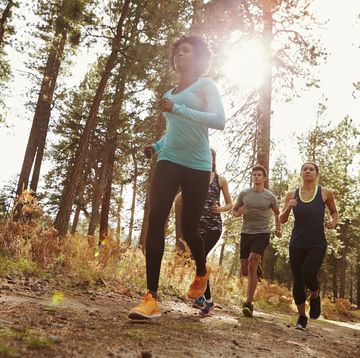Dora Atim didn’t have many followers on TikTok until she posted a short clip of herself doing warm-up drills ahead of a trail race while four white men stared. ‘Take a picture darlin’,’ she wrote. But 900,000 views and 3,000 comments later, she was exhausted from reading other people’s opinions about why they were gawking at her.
‘Not that I’m the only person doing this stuff, but it can be so difficult being among those people that are trying to create change,’ she says. ‘It’s been tiring, but I went from 80 followers to about 2,500, and a lot of them are Black women, so I was like, “Winning!”’
Growing up in west London, Atim, 30, was initially a boxing enthusiast who ran as part of her training. Once she joined running groups, however, the sport took over. She started showing up at the Nike+ Run Club in White City, then the London-based groups Track Mafia and Run Dem Crew. ‘I loved the social aspect of it,’ she says. ‘It wasn’t about getting PBs, though obviously I want to get faster. That isn’t the be-all and end-all. It became a lifestyle.’
What everyone's reading
Atim discovered the joys of off-road running when lockdown caused her to move to Hampshire temporarily, but it wasn’t all positive. ‘I was running a lot because there was nothing else to do,’ she says. ‘There weren’t a lot of people who looked like me in that area and I started to feel like I didn’t belong. I’d get stopped. People would ask me what I was doing. There were all these weird interactions.’
So, in June 2020, she launched Ultra Black Running online, to support Black women and gender non-conforming people who wanted to take to the trails. Although Atim gave it that name because she wants to run an ultra, the group is less about the distance and more about the community. There’s no membership fee. You just receive a message telling you where that weekend’s run will be. It’s usually places where Londoners can feel like they’re in the countryside: Richmond Park or Epping Forest, perhaps.
‘When we started meeting regularly, it was the time of Black Lives Matter, this global uprising – everything was just on fire,’ she says. ‘We’d never have been able to have the conversations we were having there with our non-Black friends or at work because we wouldn’t feel comfortable enough. It felt so important, so we had to keep going.’
They put on their first race in July 2021, in collaboration with the event organisers Maverick. ‘We had Black food vendors, Black women DJs, bringing this abundant energy. Who has a dance floor at the end of a trail race? We did!’ Atim says.
She recognises that although running as a whole is a relatively accessible sport to take up, the extra kit and travel costs required to reach the trails can be a barrier. ‘We can remove the cost of entry, give people access to group coaching sessions and physios, and soften the blow,’ she says.
But it’s also about allowing everyone to feel like trail running is open to them in the first place. ‘Decision makers, who are you putting on your websites? What are you putting in your marketing?’ she asks. ‘I live in the city and I like trail running, but if I’m not seeing people I can relate to, I’ll feel like it’s not for me. It starts from up top.’
Q&A with founder of Ultra Black Running, Dora Atim
When did you start running and why?
‘I went to a boxing class when I was 18, I loved it and was told to start running to help improve my boxing. At the time I really did not like that idea as I was not a runner and didn't know where to begin. I did it anyway and stuck at it. I eventually joined Nike+ Run Club in White City and completed my first 10K at the Nike Women’s 10K in 2015. I then fell massively in love with running, and since then I have joined other running communities such as Run Dem Crew, Track Mafia and co-founded Last Pick Athletics Club, and then started to coach for Nike+ Run Club.’
Do you think there is anything missing from the running community?
‘Representation from every marginalised community – races and events are not always accessible to everyone. I also think race organisers can improve on engaging the communities in movement when they are situated in a specific area for their races.’
When and why did you launch Ultra Black Running?
‘I started Ultra Black at the end of June 2020 because I feel there is a lack of representation in the running world, and especially in the trail/ultra/mountain running scene. I want women and gender nonconforming folk to see themselves when they run in the trails or attend races in the future.’
What are your hopes and objectives for Ultra Black Running?
‘I’m hoping to build a community for Black women and gender-nonconforming people. It would be great to work towards a goal together, and experience different trails and other areas of natural beauty in the UK together – hopefully, we may be able to attend a trail event together in the future.’
What do you think are the barriers to running and what do you think can be done?
‘Firstly, the perceived barrier is the one that may stop us from getting started – the “I’m not fit enough” or the “I’m so slow.” Self-confidence is the first barrier that stopped me from getting started those years ago, but once you have gotten past that first stage, then you are ready to make magic! Secondly, races need to market for a wider audience as opposed to the standard “run club” runner – there are so many people who would run races if they were inviting and approachable, and that starts with conversations being had up at the top to manage the marketing of these events.’
What do you think non-BIPOC members of the running community can do to ensure BIPOC are better represented at events and races?
‘They can help by listening to BIPOC when we are speaking on experiences and issues. By listening, they will gain a better understanding of how BIPOC can be supported and be better represented in the community.’
Fitness in general is very hypergendered and there needs to be more accessible spaces for non-binary and gender nonconforming folx. What would you like to see happen in the landscape of running to change this?
‘I feel that there are many ways in which gender-nonconforming people can be better supported, and I am still educating myself on how. I would love for those who are non-binary and gender non-conforming people to feel that Ultra Black Running is a safe space for them, so I will listen and consider how the landscape of running can be accessible for them, and have their stories amplified.’
Can you talk us through what your running routine normally looks like in a week?
‘Outside of training for races and events, I will normally run four to five times a week, and I do mobility exercises after most of my runs. At the moment I am running five times a week and will vary my runs by doing easy runs, speed sessions, hill runs and a long run on the weekend. I will also do strength sessions twice a week dependent on how my body is feeling to ensure I am maintaining a strong body! I’ll recover harder then go again.’
What do you do when motivation is low?
‘When my motivation is low, I try to think about what is making me not want to run. Most of the time it’s because I am tired or have a lot going on, so I will always need to be mindful of that. If I’m tired but still want to head out I will cut the time or distance that I am planning to run to ease me from pressure. I also love to run to house music, so I’ll often make a new playlist and give it a whirl in the trails!’
What do you love about trail running? What would you say to encourage others to give it a go?
‘When I am in the trails, I really get to unwind and take everything in. For me, all I’m thinking about is where I’m going to place my foot next – running through trails requires more attention due to the terrain. For those who are wanting to give it a go, start small – set a time or landscape/viewing point that you want to visit. When you are out there, make sure you treat it like any other run: warm up, do drills, stretch and recover hard! Tour body will thank you for it. Lastly, I would LOVE to see the places you guys explore, so tag me on IG @doradontexplore.’
Like this article? Sign up to our newsletter to get more articles like this delivered straight to your inbox.


